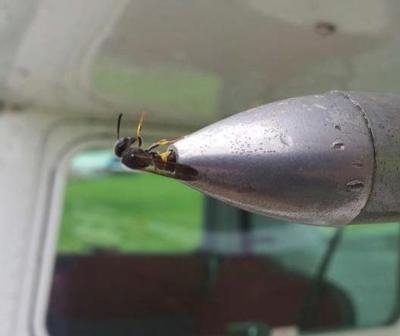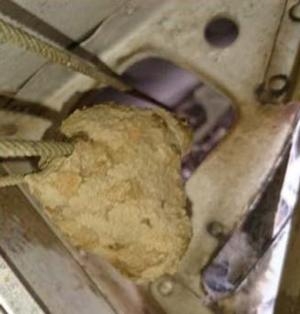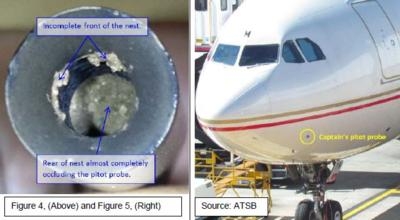Mon, Mar 28, 2016
Urges Pilots Of Any Aircraft Type To Be Aware Of The Potential Hazard
The Civil Aviation Safety Authority (CASA) in Australia has issued a safety bulletin warning of the dangers posed by mud dauber wasps nesting in airplanes.

According to the bulletin mud dauber wasp nests pose a significant safety hazard to all aircraft because they typically remain undetected in aircraft structure, flight controls, drains and flight instrument pitot static systems until during or after take-off. A wasp nest can completely block pitot tubes, fuel tank vents and drains.
Mud dauber wasps will build a nest in any available cavity. A recent SDR investigation found a number of wasp nests inside the wing of a Cessna 182, in the cavity formed between the rear spar and the flap fairing. There was also one large wasp nest entirely suspended on the flight control cables in the rear fuselage.
Wasp nest and insect blockages in pitot tubes are not limited to small aircraft. Between 2010 and 2015, CASA received approximately 20 SDRs detailing departure gate delays, aborted take-offs and air turn-back occurrences due to wasp nest infestations in the pitot tubes of large aircraft in Australia alone. Overseas reports detail fatal accidents which have been attributed to wasp nests blocking the pitot tube, resulting in loss of airspeed indication.
A typical example occurred in 2013 when an Airbus A330 suffered a rejected take-off in Brisbane, Australia, due to an airspeed indicator failure which was only detected during the take-off roll. During the subsequent inspection it was found that the Captain’s pitot probe was almost totally obstructed by an insect nest, consistent with mud-dauber wasp nest residue.

CASA recommends that owners and operators review their procedures against the manufacturer’s maintenance instructions and recommendations with regard to parking and storage.
In addition:
- Install pitot / static and vent covers any time the aircraft is parked.
- Consider installing approved fuel vent screens or removable drain/vent covers and engine compartment blanks, as well as installing tight fitting pitot / static vent covers.
- In instances where the aircraft has been stored long term in the open air, remove inspection panels before flight as required to inspect unsealed wing and fuselage cavities etc.
- Continually monitor and remove any wasp nesting sites in the general area where the aircraft is stored or maintained in accordance with appropriate insect control procedures.
- Be aware that on-ground pre-flight air data module BITE tests and/or computer checks will usually not test pitot probes or static vents for blockages.
All wasp nest and / or insect infestations and any associated defects or operational difficulties should be reported to CASA via the SDR system.
As the weather here in the U.S. warms and flying activity increases, it's good advice for pilots on this side of the planet as well.
(Images provided by CASA)

More News
Aviation Governance Secured...At Least For a While The National Business Aviation Association similarly applauded the passage of the FAA's recent reauthorization, contentedly recou>[...]
Emphasis On Growing The Future of Aviation Through Concentration on 'AFFORDABLE FLYERS' It's been a number of years since the Latest Edition of Jim Campbell's HUGE SportPlane Resou>[...]
Amazilia Aerospace GmbH, Develops Digital Flight Control, Flight Guidance And Vehicle Management Systems Textron eAviation has acquired substantially all the assets of Amazilia Aer>[...]
Honeywell's Primus Brings New Tools and Niceties for Hawker Operators Hawker 4000 business jet operators have a new installation on the table, now that the FAA has granted an STC f>[...]
Company Celebrates Niche-but-Important Advancement in Industry Standards Echodyne has announced full integration of its proprietary 'EchoFlight' radar into the e American Aerospace>[...]
 Bolen Gives Congress a Rare Thumbs-Up
Bolen Gives Congress a Rare Thumbs-Up The SportPlane Resource Guide RETURNS!!!!
The SportPlane Resource Guide RETURNS!!!! Buying Sprees Continue: Textron eAviation Takes On Amazilia Aerospace
Buying Sprees Continue: Textron eAviation Takes On Amazilia Aerospace Hawker 4000 Bizjets Gain Nav System, Data Link STC
Hawker 4000 Bizjets Gain Nav System, Data Link STC Echodyne Gets BVLOS Waiver for AiRanger Aircraft
Echodyne Gets BVLOS Waiver for AiRanger Aircraft





